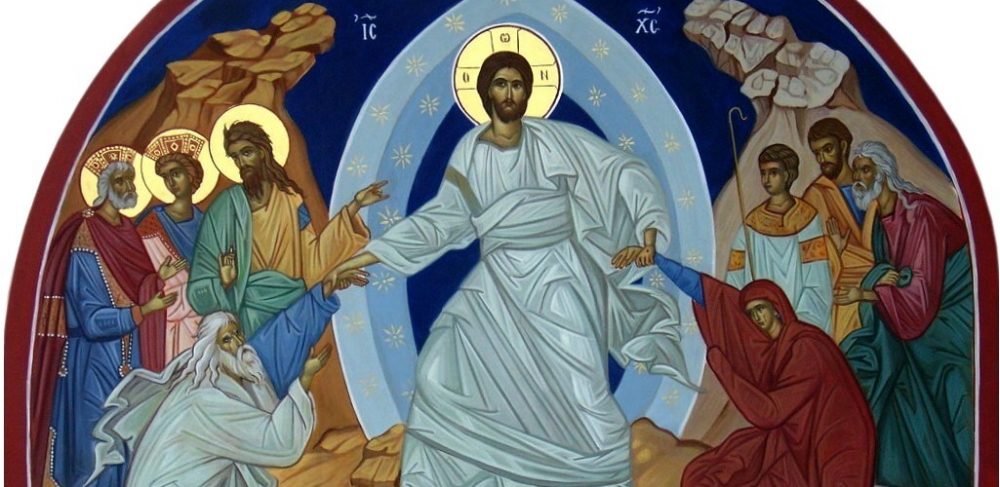Here we provide information about the images we include on our page headers!

The Anastasis
The Anastasis, Christ’s Descent into Hades, or The Holy Resurrection of Jesus Christ, by the hand of Maria Lavie. We abridged the following excerpt, written by Father Jeremy of Orthodox Road: “This is the primary icon of Pascha (Easter). It depicts Christ’s radical descent into Hades to save those who have died in the flesh. The golden bars by his feet are the gates of Hades, which he has broken and torn apart. You may also note the skeletal figure (in the lower mid-right) who is chained up: that is Death and/or Satan. He has been bound and killed by Christ, which is why all throughout Pascha we sing ‘Christ has trampled down death by death.’ The two figures whom Christ has grasped and is pulling from tombs are Adam and Eve, symbolizing that His victory redeems all mankind, back to the beginning.” The artist, Maria Lavie, is a modern French iconographer who trained in Patmos, learning the traditional Byzantine style of iconography.
The Communion of the Apostles
The Communion of the Apostles, by the hand of Khouria Heather Sommer. The parish of Holy Spirit Orthodox Church commissioned this painting for our iconostasis mural. You’ll notice that Jesus is depicted twice. We abridged the following explanation of the “doubled” Jesus in communion icons from David, author of RussianIcons.WordPress.com: “Christ stands at an altar, giving communion to the Apostles, who approach from left and right. Christ is generally shown twice, at left in the so-called metadosis (imparting) of the bread, and at right in the so-called metalepsis (partaking) of the wine. This represents Christ giving the communion in and to the Church on earth — the Church as one related communion.” The artist, Khouria Heather Sommer, is a celebrated modern iconographer.

Candles, book, and icons
Candles, book, and icons (Adobe stock image). We love the subdued, contemplative, and peaceful mood of this photo. Realizing the irony since we are writing on a computer for a web publication, our parishioners often remark they experience a profound connection to the past through our ancient customs. The simple and rustic ambiance of this photo helps to convey the communion with antiquity that many experience at Holy Spirit Orthodox Church. Note – as the book and icons are out of focus, we are not sure exactly what is pictured. The book is quite difficult to decipher. The typeface is in the Cyrillic alphabet, and we recognize the name Jesus Christ on the fourth line of the left page. The icon on the left might be a reproduction of The Virgin of Vladimir (12th c. Byzantine). We are not sure if the middle icon is a particular historical reproduction, or if it might be a modern Christ the Teacher (motif of Christ with an open book). The icon on the right might be a reproduction of the Rublev Trinity (15th c. Russian).

The Jordan River Baptismal Site
The Jordan River in Yardenit Baptismal Site – Galilee, Israel (Adobe stock image). Jesus’ baptism by John in the Jordan River is recorded in all four Gospels, and we will share the account found in Matthew 3:13-17: “Then Jesus came from Galilee to John at the Jordan to be baptized by him. And John tried to prevent Him, saying, ‘I need to be baptized by You, and are You coming to me?’ But Jesus answered and said to him, ‘Permit it to be so now, for thus it is fitting for us to fulfill all righteousness.’ Then he allowed Him. When He had been baptized, Jesus came up immediately from the water, and behold, the heavens were opened to Him, and He saw the Spirit of God descending like a dove and alighting upon Him. And suddenly a voice came from heaven, saying ‘This is My beloved Son, in whom I am well pleased.'” We commemorate Jesus’ baptism by John in the Jordan River on the Feast of Theophany.

Jesus Christ Pantocrator, detail from Deësis Mosaic in Hagia Sophia
Jesus Christ Pantocrator, detail from Deësis Mosaic in Hagia Sophia of Constantinople (modern Istanbul, Turkey). Hagia Sophia was built in 537 as a magnificent Orthodox cathedral, the largest Christian cathedral in the world. It was the capital of the patriarchate of Constantinople for several hundred years, until Catholics from France, Italy, and the Holy Roman Empire briefly ousted the Byzantine Orthodox at the end of the Fourth Crusade in 1204 (the Sack of Constantinople). Hagia Sophia was then designated a Catholic cathedral until the Byzantine Orthodox reclaimed their empire in 1261. Hagia Sophia was restored to an Orthodox cathedral, and a consequent Byzantine art revival took place. During this revival, the towering Deësis Mosaic of Jesus Christ Pantocrator (flanked by the Theotokos on His right and St. John on His left) was created. Sadly, Constantinople fell to the Ottoman Muslims in 1453 and much of the Christian imagery in Hagia Sophia was destroyed. Thankfully, the Ottoman soldiers were ordered to stop their destruction (so that the sultan might enjoy an intact cathedral, which he had converted into a mosque).
The Deësis Mosaic was left exposed for about three centuries. Sometime in the 1700s, all Christian images in Hagia Sophia were covered. Then in 1847, Sultan Abdülmecid ordered a complete restoration of Hagia Sophia. The Fossati brothers oversaw the restoration, and saved the Deësis Mosaic from falling off the wall and becoming completely destroyed. Hagia Sophia became a museum in 1935, which allowed visitors to view the Deësis Mosaic as well as other Byzantine Orthodox (and Ottoman Muslim) art. Hagia Sophia reverted to a mosque in 2020, but the Deësis Mosaic and other beloved Christian imagery are still displayed. Sources: Late Byzantine Naturalism (video with Dr. Evan Freeman), How the Deësis Mosaic was Saved (Bob Atchison), Hagia Sophia Restoration (HagiaSophia.com)
